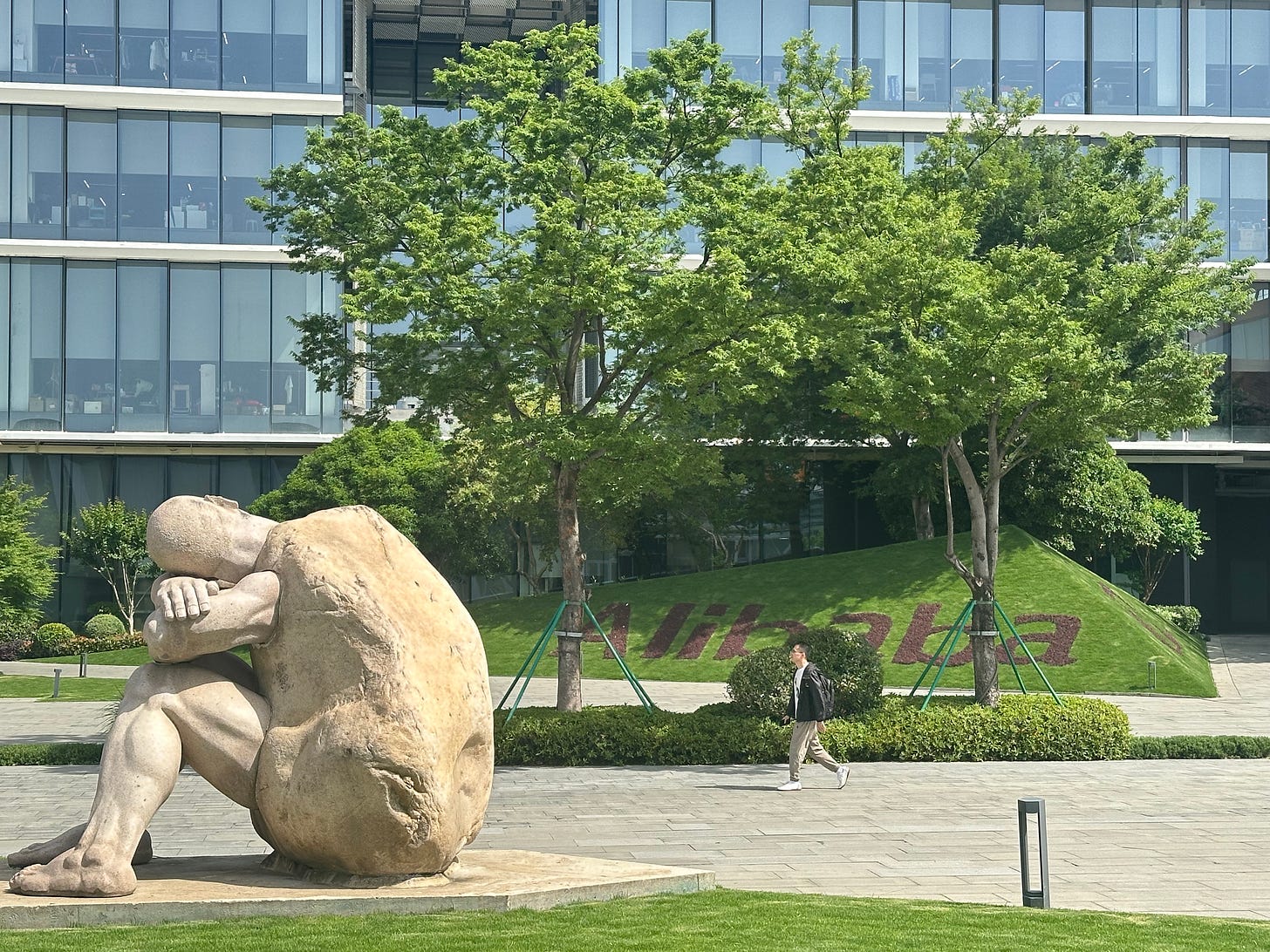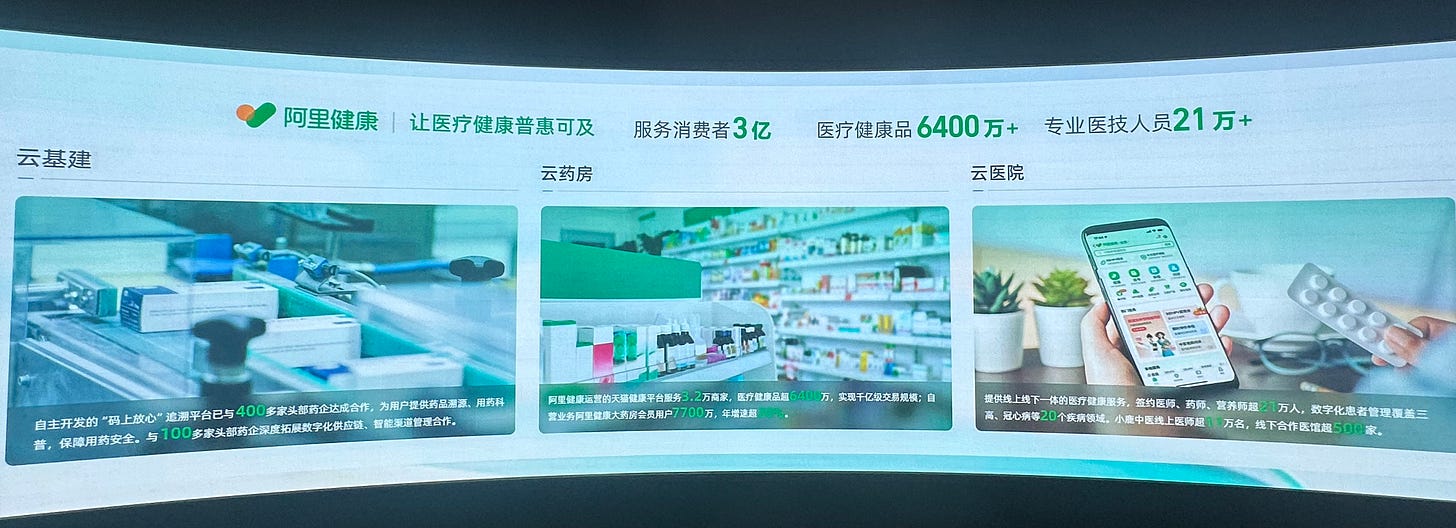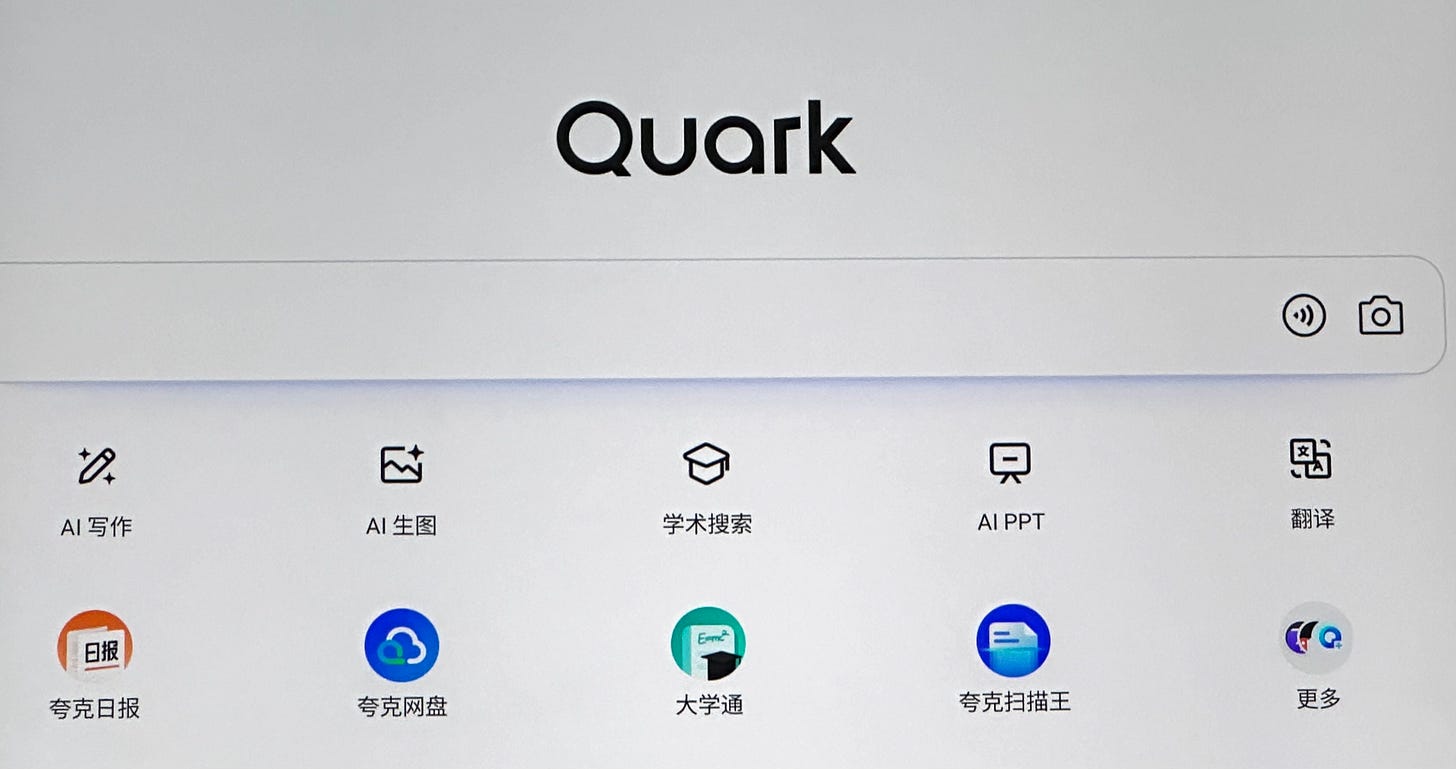Diagnosing Alibaba (Pt 1 of 2): What's China’s Internet Giant doing on Health? I visited HQ to find out.
Six years after working as a Medical Advisor for AliHealth, I returned to Hangzhou to see what has changed for Alibaba's digital health strategy in China.
🔬This is a 2-part deep dive on Alibaba’s role in China’s digital health landscape, in the CHP Real Diagnosis series.
Here, in Part 1: I cover my visit to Alibaba HQ this week in Hangzhou, reflecting on how the company’s history, mission and vision has changed since I last worked at Alihealth.
Next time, in Part 2: A deeper look at Alibaba’s healthtech ambition, breaking down the good and the bad in its structure and scope — as well as the implications for patients, providers, competitors and industry partners.
Alibaba needs no introduction. It is one of China’s biggest tech and internet giants, born in Hangzhou (the city now also known as the origin of DeepSeek) in 1999, and well known around the globe.
The last time I was here on “campus” (as employees call it) in 2019 at HQ, I wore a badge and owned a desk in Building 9, working as a Medical Advisor at AliHealth, its health subsidiary. This week, I returned as a guest.
Alibaba’s story of transformation has become the stuff of tech legend. In 26 years, the company has grown from a B2B marketplace into much more than an e-commerce powerhouse, pushing founder and former English teacher Jack Ma, to global prominence as a shining symbol of the China dream: hundreds of biographies and self-help books have been written about his life story and the endless possibilities inspired by hard work and ambition.
Unlike Amazon, which has maintained an arguably tighter focus on e-commerce, Alibaba has built a broad, horizontal infrastructure, in order to become a holistic operating system for digital China. Today, it is a sprawling tech conglomerate with multiple IPO’s, which already has and continues to transform the way people interact with technology in their everyday, from digital wallets, logistics and deliveries, to cloud computing, as well as healthtech.
When I was working here six years ago (which, equates to several past lifetimes in China’s ever-accelerating tech landscape), Alibaba’s health strategy was still tentatively building from its natural strengths in e-commerce, with primary focus on drug deliveries and digital pharmacies.
Things look quite different now.
In this 2-part series, I want to share some highlight snapshots and reflections from my recent visit. I believe that understanding the structure and history of the company provides essential context in order to better analyse its wider incentives, mission and vision, and to predict how these influence health and care in turn.
My Alibaba Journey
In 2019, I joined AliHealth for a stint as a Medical Advisor, working from Alibaba’s headquarters in Hangzhou, and occasionally its high-rise offices in the Northeast of Beijing.
The experience was fascinating, and at times, dystopian, in the way that only big tech can be — particularly as I had spent the majority of my career thus far as a doctor on UK hospital wards. This was my first time working and speaking at length in professional Mandarin for a Chinese company, let alone the biggest name around in tech. From extended screen-time to back-to-back meetings, each day felt fresh and novel for me, even the most seemingly monotonous routines.
Alibaba had absorbed elements of Silicon Valley culture: a vast, beautiful campus built around a landscaped lake, glass towers encircling manicured gardens, and employees doing laps around the water on their breaks. Nested within each very tall, very square building, canteens served everything from regional Chinese dishes to burgers and pizza, and convenience stores sold branded Ali-notebooks and pens that employees could buy as gifts for outside friends and family. There were often company festivals on-site, with themed gifts and interactive games, and regular pop-ups where staff queued for prizes and snacks.
Alibaba also proudly maintained its own culturally Chinese imprint. When I joined, I had been bemused to discover that employee is asked to choose a 花名 (huaming, or nickname), by which they are exclusively known by. This meant that colleagues rarely knew of each other’s real names, even after years of working together. The names were often whimsical, sometimes aspirational, and I wasted days picking out pretentiously obscure Chinese characters from Tang Dynasty poetry in order to impress colleagues with my sophisticated taste.
I was also fascinated by the long-service awards: stamped gold rings, jade pendants and carved seals given at 1, 3, 5, and 10-year marks. These emblems were proudly displayed in security-monitored cases at the centre of the lobby entrance where my colleagues and I beeped in and out everyday, glowing and calling out to us as the symbolic rewards of long term loyalty.
By then, the “996” phenomenon — working from 9am to 9pm, six days a week — was already widespread in Chinese tech culture, and Alibaba was no exception. It was regularly and intensely hyped in media, and so I had assumed it to be more myth than reality. But day 1 proved me wrong. I watched on, rather shocked, as my colleagues worked through each morning, pulling out foldable beds or neck pillows for post-lunch naps, then returning to their screens until late at night. Some even slept at the office to get an early start the next day - and they each seemed gladly resigned to the process. This was simply what you had to do to be here at the prestigious Alibaba.
Now, six years later, I was finally back on-site, at Xixi campus. It felt incredibly nostalgic to walk through the familiar main entrance and across that iconic landscaped garden again.
But this time, I came for a different purpose: to visit the official Alibaba showroom. I used to walk past the building every day to and from work, but I had never set foot inside as an AliHealth employee. This highly curated exhibition space is typically reserved for guests such as government officials or foreign partners. It lays out an impressive and comprehensive history of the company, including values, capabilities and the most recent innovations. I was thrilled to finally step inside, discover what had changed since I last worked here, and learn about how Alibaba sees itself and health today – whether intentionally, or otherwise.
From E-Pharmacy to Digital Health Platform
AliHealth was established in 2014 after Alibaba Group acquired CITIC 21CN, a pharmaceutical data platform company. The goal was to fold health into Alibaba’s wider ecosystem and apply its strengths in e-commerce, logistics and cloud computing to digital healthcare.
When I joined in 2019 as a Medical Advisor, the company’s health strategy still felt rather scattershot. I was asked to provide input on everything from whether the US Diagnosis-Related Groups (DRGs) model could work in China’s reimbursement system, to advising the investment arm on which fledgling medtech startups to acquire, to sitting with weary engineers decoding ECG waveforms from medical textbooks. I enjoyed my time in this scaled-up start-up, but there was not much coherence.
Things have changed. AliHealth has become one of the shining standouts in Alibaba’s ever-expanding portfolio of tech-driven public service platforms. It is now a publicly listed healthtech platform, structured around a licensed internet hospital framework. This sophisticated digital infrastructure allows it to connect doctors, medications and insurance on one platform. Its current model rests on four interlinked pillars:
1. E-pharmacy Infrastructure
AliHealth’s roots remain in online drug sales, serving over 300 million users and more than 35,000 merchants through Alibaba’s Tmall. Product offerings range from over-the-counter medications to prescription drugs, supplements medical devices, as well as Traditional Chinese Medicine.
Prescriptions issued online are processed through AliHealth’s internet hospital and fulfilled via an integrated logistics system. This includes cold-chain warehousing for temperature-sensitive meds, same-day delivery in urban zones, and pickup options for patients preferring offline channels.
2. Online Consultations and Chronic Care
AliHealth now connects patients directly with licensed physicians, with the pandemic accelerating a dramatic expansion in virtual care. The platform offers 24/7 video consultations across general and specialist care, asynchronous follow-up chat, and AI-powered triage tools for preliminary symptom assessment
Once a consultation ends, prescriptions are issued digitally and dispatched through AliHealth’s pharmacy logistics chain. For chronic conditions like hypertension or diabetes, patients can opt into ongoing care plans: scheduled follow-ups, medication refills, health reminders and algorithm-generated wellness advice. The aim is a full-loop pathway from inquiry to treatment to long-term condition management.
3. Insurance and Paid Service Bundles
While not an insurer itself, AliHealth partners with both commercial payers and local governments to offer embedded health insurance packages. This means that users can check coverage, upload documents, and settle payments all within the app, whether that’s basic outpatient plans with digital claim filing, value-added products for chronic care and screening, or real-time reimbursement via Alipay integration.
It’s important to realise that AliHealth’s ability to grow into a full-stack digital health platform today, has rested almost entirely on the reach, infrastructure and technical depth of the broader Alibaba Group.

Show and Tell: Alibaba’s Wider Health Story
Alibaba’s digital presence in China now touches nearly every domain of daily life. The official showroom at headquarters are seemingly designed to prove this. Upon entering, visitors are immersed in a cinematic wraparound film: a glossy, 24-hour portrait of how Alibaba services (and only Alibaba services) interlace with every facet of a citizen’s day, encompassing home life and professional work from cloud to navigation, from groceries to drug delivery.
To manage this comprehensive and increasingly sprawling empire of business unites, the company restructured in 2023 into a “1 + 6 + N” model: one holding company, six major business groups (not including Ant Financial and Alipay, now legally separate) and an expanding “N” category of verticals, including AliHealth, Quark, Hema and DingTalk.

The aim was to decentralise and give each unit the freedom to innovate, raise capital and operate autonomously. But this also led to multi-headed strategies—health included. While AliHealth remains the consumer-facing core, many other subsidiaries now contribute to healthcare delivery.
E-Commerce | Western parallel: Amazon
Taobao (launched 2003)
China’s largest C2C platform with over 900 million users. While it doesn’t offer healthcare directly, it amplifies health retail by driving traffic to AliHealth storefronts—especially during mega-sales like Singles’ Day.
Tmall (spun out 2008)
Alibaba’s B2C platform for brands, where Tmall Pharmacy lives, hosts over 100,000 domestic and global brands. Managed by AliHealth since 2015, Tmall Pharmacy offers prescriptions, OTC products, wellness goods and health services. This was one of the first direct health-business integrations in Alibaba’s empire.
Logistics & Local Services | Western parallel: FedEx meets Shopify; DoorDash
Cainiao (founded 2013)
Alibaba’s logistics backbone handles over 5 billion parcels monthly. It is a confirmed AliHealth partner, delivering medications via cold-chain and same-day systems. Cainiao was key to COVID-era emergency supply chains and last-mile delivery.
Ele.me (acquired 2018)
Alibaba’s food and instant delivery app owns 30% market share in China. It has now extended to cover 24/7 OTC drug delivery via a formal collaboration with AliHealth. In urban areas, Ele.me offers fast-track health fulfillment tied to location services from Gaode/Amaps.

Navigation & Accessibility | Western parallel: Google Maps
Gaode / AutoNavi (acquired 2014)
China’s most-used map app has over 100 million daily active users. It powers navigation, real-time traffic, public transport, and location services for third-party apps and EV dashboards. While not formally integrated with AliHealth, it indirectly supports healthcare access via hospital location data and route optimisation for deliveries. A lesser-known disability-friendly feature really impressed me on the showroom tour: Gaode has independently created a sophisticated accessibility mode on its maps, featuring wheelchair routes, voice navigation and visual disability support. A product like this demands nationwide data capture and fine-grained modelling. This is an impressive signal of Gaode’s, and by extension Alibaba’s, technical reach and execution power.

Fintech & Payments | Western parallel: PayPal meets Apple Wallet
Alipay (launched 2004)
Used by over a billion people, Alipay is core to Alibaba’s health strategy. Users pay for AliHealth consultations, upload insurance claims and track reimbursements. In 2024, Alipay launched its own AI Health Manager, a symptom-checker and report interpreter which personalises health content. While this is branded separately, it overlaps with AliHealth’s ecosystem (and likely shares backend integration).
Cloud Infrastructure & AI | Western parallel: AWS; DeepMind
Alibaba Cloud (launched 2009)
China’s largest cloud provider took up 34% domestic market share in 2024. It collaborates with AliHealth to provide cloud computing, data storage, and AI services to hospitals and healthcare companies, and also co-developed ET Medical Brain 2.0 to power triage tools, smart prescriptions and hospital SaaS. During the pandemic, it became the infrastructure backbone of COVID response apps across China.
DAMO Academy (founded 2017) | Western parallel: Google DeepMind
Alibaba’s frontier AI lab has made headlines with PANDA, its AI model for early pancreatic cancer detection via plain CT, which was granted FDA Breakthrough Device status in 2024 (the first such recognition for a China-developed healthtech algorithm). The model’s accuracy in identifying early-stage lesions in one of the world’s deadliest cancers has generated widespread interest. PANDA is now undergoing provincial trials with AliHealth as deployment partner, along with other diagnostic pilots including lung nodule classification to diabetic retinopathy and cervical cancer risk scoring. These tools are far from mass adoption, but they mark a clear shift: AliHealth is moving beyond retail into public health infrastructure, enabled by Alibaba’s data scale, research muscle and platform reach.
Consumer AI | Western parallel: OpenAI
Quark (relaunched 2023)
Originally a search and cloud app, Quark is now Alibaba’s flagship GenAI product, powered by its own Qwen large language model. It offers added health features like document summarisation, medical Q&A and health record parsing, but there’s no confirmed integration with AliHealth. For now, Quark remains a consumer-facing AI assistant with adjacent but separate ambitions from AliHealth’s clinical work.
Lasting Impressions
My tour around the Alibaba showroom felt like walking through a digital national museum, where each display out-competed the next, to show off ever more impressive successes in a glittering portfolio. Behind glass sat carefully curated relics of the company’s early days: first-generation payment terminals, the inaugural item sold online (a second-hand camera). No one does myth-making quite like Alibaba, after all. And among all the shine, there was most definitely an extra-grandiose moment to stand out against the rest: a flamboyant, floor-to-ceiling painted mural of Jack Ma and his early team, depicted atop the Great Wall of China.

But the myth is evolving. Alibaba has moved beyond e-commerce into national infrastructure, and increasingly, public service delivery, and health is very much part of that expansion. AliHealth has grown from a pharmacy spinout into a multi-layered platform that reflects Alibaba’s deeper ambitions: to plug into China’s long-term challenges, includingageing, health service access and digital care governance.
Alibaba’s health strategy is ever-ambitious, yet it is also growing more diffuse than ever. AliHealth may front the services, but delivery runs through Cainiao, diagnostics through DAMO, payments through Alipay, and fulfilment through Ele.me. What began as integration now looks more like orchestration.
As I walked out of that showroom, I had many questions that the tour guide had been unable to answer. Will Alibaba's decentralised health apparatus cohere into a real system, will it continue to expand in parallel silos? And more importantly: can this architecture actually deliver better health outcomes?
In Part 2, I’ll take a closer look at how Alibaba’s health strategy really adds up: the strengths and fractures in its structure, the scope of its ambitions, and what all this means for patients, providers, industry partners as well as competitors.
🔬This is Part 1 of 2 in my deep dive on Alibaba’s role in China’s digital health landscape, in the CHP Real Diagnosis series.














Fascinating. I live in Wuhan, have some appreciable experience with healthcare in China, and my immediate knee jerk take is it’s going to make Amazon’s approach look inferior and mildly silly. Looking forward to Part 2.
Really interesting insider look at this “giant”. Honestly, I’m wary of all “big tech”, but Alibaba more than most, and more so of Jack Ma. There’s something off about him, maybe it’s just me, the over the top impossible marketing story, the greed and self-destructiveness of “996”, I don’t know. Looking forward to part 2.